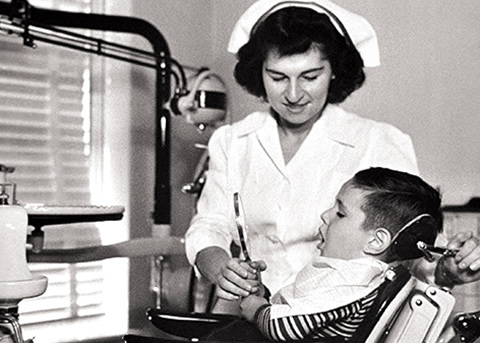It’s not easy for dentists to see what’s going on inside a patient’s teeth. They’ve traditionally relied on X-rays, but X-ray machines emit ionizing radiation that can pose a health risk with prolonged exposure (limiting the number of X-rays a patient can have each year). Prof. Andreas Mandelis, a U of T engineer, has developed a promising alternative.
His invention, known as “photothermal imaging radar,” can peer inside a tooth and produce a higher-contrast image than conventional X-rays, but without the radiation risk. And it can detect dental problems before they would be visible on an X-ray.
Over time, bacteria eat away at the material inside a tooth. This process of demineralization causes lesions, known as caries; left untreated, the lesions can lead to infections, cavities and even the loss of the tooth.
In photothermal imaging radar, the tooth is illuminated with a low-energy, pulsating laser beam, which penetrates several millimetres into the tooth. The tooth then emits heat that can be detected with an infrared camera. Because caries have different optical and thermal properties than healthy regions of teeth, the resulting image clearly distinguishes between healthy and damaged areas. (The tooth never heats up by more than one degree Celsius, so the patient doesn’t feel anything.)
Mandelis, who teaches in the department of mechanical and industrial engineering, has spent the last 10 years developing the technology. Working with a dentist colleague, he started a spinoff company, Quantum Dental Technologies, which already markets a commercial version of a simpler device. It’s called the Canary System – named for the proverbial canary in the coal mine – and provides an early warning of tooth decay. Mandelis describes the device as a “single point instrument:” The dentist uses a hand-held laser and infrared detector to examine teeth one spot at a time. It’s already being used by a number of dentists in Toronto.
While the Canary System provides data for one spot, Mandelis’s ultimate goal is to develop a device that can image a whole row of teeth at once, just like today’s X-ray machines. With early enough detection, caries can be filled with special gels that can help remineralize the tooth. “The hope is that you will see demineralization at a very early stage, so you don’t have to ‘drill it and fill it,’ as dentists do today,” Mandelis says.
With most of the technical hurdles behind him, perhaps the greatest remaining challenge is to get the price down. Today’s dental X-ray machines typically sell for about $70,000. Mandelis is aiming to have a complete photothermal imaging radar package – including the laser and the camera – available at a competitive price.
The applications may reach beyond dentistry: The same technology could aid in industrial inspection processes – looking for cracks in metal, for example – especially in the automotive and aviation sectors, Mandelis says.
Recent Posts
For Greener Buildings, We Need to Rethink How We Construct Them
To meet its pledge to be carbon neutral by 2050, Canada needs to cut emissions from the construction industry. Architecture prof Kelly Doran has ideas
U of T’s 197th Birthday Quiz
Test your knowledge of all things U of T in honour of the university’s 197th anniversary on March 15!
Are Cold Plunges Good for You?
Research suggests they are, in three ways





